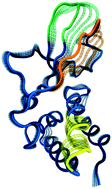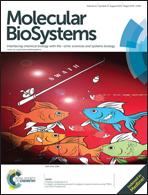In silico study of VP35 inhibitors: from computational alanine scanning to essential dynamics†
Abstract
In recent years the Ebola virus has spread through several countries in Africa, highlighting the need to develop new treatments for this disease and boosting a new research effort on this subject. The Ebola virus Viral Protein 35 (VP35) carries out multiple functions necessary for virus replication and infection, in particular interfering with (IFN)-α/β signaling. Recently, VP35 has been crystallized in complex with small organic molecules able to inhibit its interaction with viral nucleoproteins, thus reducing Ebola infections of cultured cells. In this work, starting from these structures, we carry out a computational study aimed at investigating the energetic and dynamical aspects of the interaction between VP35 and its ligands at the atomic level. Molecular dynamics simulations, computational alanine scanning, root mean square fluctuations bootstrap analysis and essential dynamics analysis were performed. Our results expand the experimental ones obtained in previous works, adding information about the interactions landscape with the identification of a set of new hot-spots residues exerting a critical function in the protein–ligand interaction. Moreover we characterized the dynamics of the complexes, showing that the presence of ligands modifies the overall protein dynamics as well as the behavior of particular protein segments.

- This article is part of the themed collection: Chemical Biology in Molecular BioSystems

 Please wait while we load your content...
Please wait while we load your content...